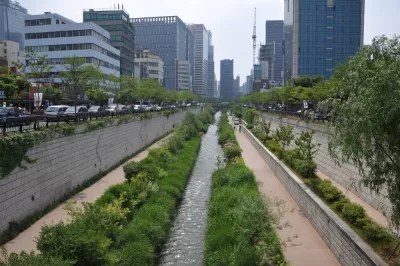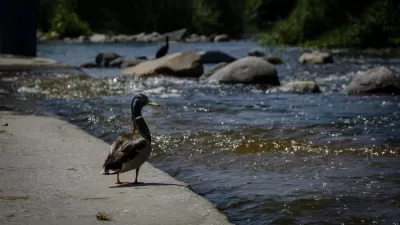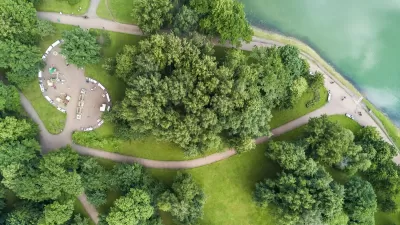As more cities "daylight" the rivers and waterways formerly interred underground to culverts and stormdrains, a process for ensuring community leadership and equitable outcomes is also coming to light.

Jenny Hoffner writes on the potential for cities to change the fate of urban watersheds:
Urban rivers that have been forgotten or buried underground for years often wind their way through neighborhoods that also have been forgotten, marginalized, or intentionally burdened with infrastructure like landfills, power plants, and sports arenas that damage the quality of life for residents.
For example, in and around the busiest airport in the world, Atlanta’s Hartsfield-Jackson International, the Flint River can be found running through pipes under parking lots and runways. Many of the neighborhoods that once stood there, and the people who once called those neighborhoods home, are long gone, bought out in favor of airport expansion.
Until we can address both the marginalization of rivers and of their neighbors, it will be impossible to create thriving communities with healthy rivers and clean water for all. Healthy rivers and communities share similar attributes, including diversity, interconnection, productivity, and resilience. And the health and vitality of both are intertwined.
There is a remedy for the situation, however, which Hoffner terms "equitable urban river restoration," or the process of rediscovering and connecting to urban rivers in a community-led process. Numerous case studies already exist, according to Hoffner, who details examples from New York City and Atlanta and lays out a four-step process for success.
FULL STORY: Restoring Our Hidden Rivers: Revisiting Urban Waterways with New Eyes

Alabama: Trump Terminates Settlements for Black Communities Harmed By Raw Sewage
Trump deemed the landmark civil rights agreement “illegal DEI and environmental justice policy.”

Study: Maui’s Plan to Convert Vacation Rentals to Long-Term Housing Could Cause Nearly $1 Billion Economic Loss
The plan would reduce visitor accommodation by 25% resulting in 1,900 jobs lost.

Planetizen Federal Action Tracker
A weekly monitor of how Trump’s orders and actions are impacting planners and planning in America.

Waymo Gets Permission to Map SF’s Market Street
If allowed to operate on the traffic-restricted street, Waymo’s autonomous taxis would have a leg up over ride-hailing competitors — and counter the city’s efforts to grow bike and pedestrian on the thoroughfare.

Parklet Symposium Highlights the Success of Shared Spaces
Parklets got a boost during the Covid-19 pandemic, when the concept was translated to outdoor dining programs that offered restaurants a lifeline during the shutdown.

Federal Homelessness Agency Places Entire Staff on Leave
The U.S. Interagency Council on Homelessness is the only federal agency dedicated to preventing and ending homelessness.
Urban Design for Planners 1: Software Tools
This six-course series explores essential urban design concepts using open source software and equips planners with the tools they need to participate fully in the urban design process.
Planning for Universal Design
Learn the tools for implementing Universal Design in planning regulations.
Caltrans
Smith Gee Studio
Institute for Housing and Urban Development Studies (IHS)
City of Grandview
Harvard GSD Executive Education
Toledo-Lucas County Plan Commissions
Salt Lake City
NYU Wagner Graduate School of Public Service





























